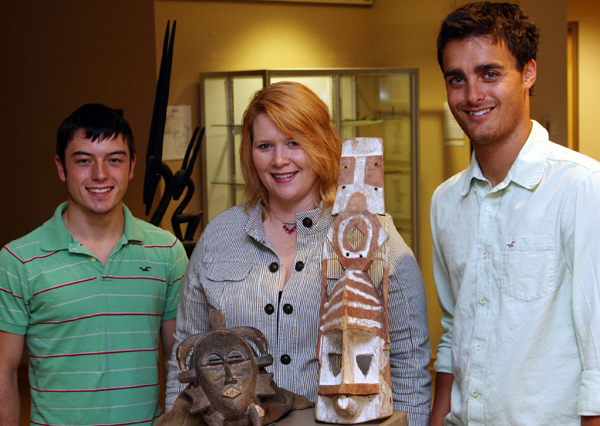 You’re driving home from the art museum and your kids are talking about an amazing mask they saw there.
You’re driving home from the art museum and your kids are talking about an amazing mask they saw there.
Like most museum visitors, they either didn’t read the label or quickly forgot it.
"It was in the Africa gallery, it was a mask, and it had horns" is all you’ve got to work with.
If the museum you’ve just left is the Indianapolis Museum of Art, don’t worry. Just go to your computer, Google "IMA African horn mask," and click on the first entry that begins with "IMA."
Up comes the IMA website and the Bidyogo People ox helmet mask.
"That’s it!" the kids shout as the photo and complete description appear—a teachable moment brought to you by Wabash sophomores Colin Fleck and Clifford Hull.
Creating such a resource for IMA visitors was the final step in their eight-week internship at the museum last summer, a project supervised by Wabash Assistant Professor of Art Elizabeth Morton. Their internships were funded by The Center of Inquiry in the Liberal Arts at Wabash.
The College’s art historian and an expert in African Art, Professor Morton was working as an adjunct for the IMA in May 2008 to improve the documentation of the museum’s vast Eiteljorg Gallery of African Art and write a catalogue about the collection. Seeing the project as a great learning opportunity for Wabash students, she brought Fleck and Hull along as interns.
Fleck and Hull’s "data-tagging" of all of the objects for the museum’s database is what allows you to find that "ox helmet mask of the Biyogo people" that you see on your computer screen, even if all you can remember is what it looked like. In fact, it makes it possible for you to find any object from the Eiteljorg Collection.
"Recent studies have found that a growing percentage of museum visitors do online research of objects they viewed at museums," Morton explains. "But they often don’t read, or remember, the labels.
"It’s an important project, and since nonwestern arts are not usually the priority, it is significant that Colin and Clifford have led the way at the IMA with the African collection."
"The work of the team from Wabash College helped the IMA dramatically enhance the documentation of this important collection in ways we would not have been able to accomplish without their efforts," says IMA Chief Information Officer Robert Stein.
And Fleck will continue to work with Professor Morton as her student assistant this year as she works with the graphics and photography departments at the IMA to complete the project.
"With the work he completed this summer, Colin is already familiar with the objects from the collection as well as the structure at the IMA," Morton says. "He will be invaluable in tracking down objects and documents and helping arrange photographs of them."
As for Hull?
"Having the chance to work in an art museum has led me to sincerely rethink my plans for the future," he says. "I enjoyed working at the IMA so much, I am now interested in merging my field of study, mathematics, into a future career in the art world."
See more of the IMA African Collection at http://www.imamuseum.org/explore/galleries/afr